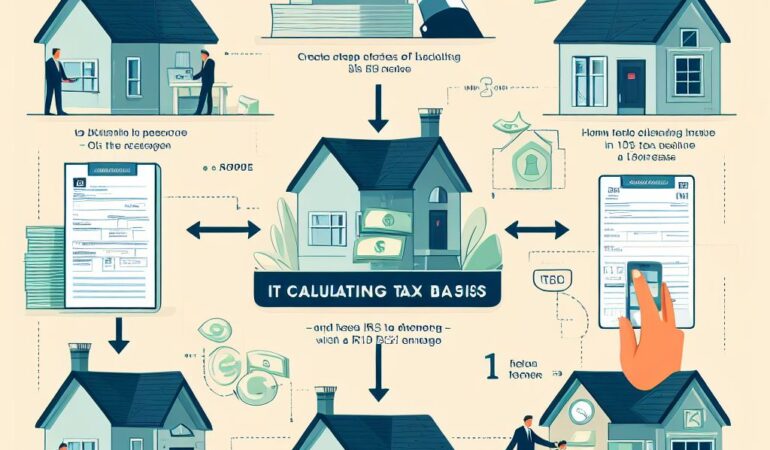So, you want to know how to calculate the tax basis in a 1031 exchange, huh? Well, you’re in luck! This article will guide you through the precise and technical process of determining the tax basis for both the relinquished and replacement properties.
From identifying the initial tax basis to accounting for improvements and depreciation, we’ll cover it all.
Get ready to dive into the world of tax calculations – it’s about to get analytical!
Key Takeaways
- Tax basis is the starting point for determining gain or loss on a property in a 1031 exchange.
- The initial tax basis of the relinquished property is determined by factors such as the original cost, additional expenses, and improvements.
- Capital improvements that increase the property’s value should be included in the tax basis calculation, while routine repairs and maintenance expenses do not affect the tax basis.
- Adjusting the tax basis for expenses and liabilities, as well as accounting for accumulated depreciation, is crucial for accurate reporting and calculating future taxable gains.
Understanding the Concept of Tax Basis
To understand the concept of tax basis, you need to know the initial value of your property for tax purposes. The tax basis is essentially the starting point for determining the gain or loss on the sale or exchange of a property. It’s crucial to accurately calculate the tax basis because it directly affects the amount of taxable gain or deductible loss you report on your tax return.
The tax basis of your property is determined by several factors. The most common factor is the original cost of the property, which includes the purchase price and any additional expenses incurred during the acquisition process. These expenses could include closing costs, legal fees, and commissions. Additionally, any improvements made to the property that have a useful life of more than one year can also be added to the tax basis.
It is important to note that certain events can adjust the tax basis of your property. For example, if you make significant improvements to the property after its acquisition, the tax basis will increase. On the other hand, if you take depreciation deductions on the property, the tax basis will decrease.
Identifying the Initial Tax Basis of the Relinquished Property
When identifying the initial tax basis of the relinquished property in a 1031 exchange, you need to consider the factors that determine the tax basis, such as the original cost, additional expenses, and any improvements made. The initial tax basis is the starting point for calculating any potential capital gains or losses in the exchange.
To better understand the concept, let’s break down the factors that contribute to the initial tax basis in a table format:
| Factor | Definition |
|---|---|
| Original Cost | This refers to the purchase price of the property. It includes the actual price paid, as well as any assumed mortgages or debts. |
| Additional Expenses | These are any costs incurred during the purchase of the property, such as legal fees, title insurance, closing costs, and broker commissions. |
| Improvements | Any enhancements or additions made to the property, such as renovations, landscaping, or building improvements, increase the tax basis. |
By taking into account these factors, you can accurately determine the initial tax basis of the relinquished property. This information is crucial for calculating the taxable gain or loss in a 1031 exchange and ensuring compliance with the Internal Revenue Service (IRS) regulations.
It’s important to note that depreciation deductions taken over the years will reduce the tax basis of the property. However, for the purpose of a 1031 exchange, the depreciation deductions are not taken into account when determining the initial tax basis.
Understanding the initial tax basis of the relinquished property is essential for a successful 1031 exchange. By accurately identifying and calculating the tax basis, you can make informed decisions to maximize tax benefits and optimize your real estate investments.
Accounting for Improvements and Depreciation
To accurately calculate the tax basis in a 1031 exchange, you must account for the improvements made to the relinquished property and the depreciation deductions taken over the years.
Here are four key points to consider when accounting for improvements and depreciation:
- Capital improvements: Any enhancements or additions made to the property that increase its value should be included in the tax basis calculation. This could include renovations, expansions, or upgrades that have been made over time.
- Repairs and maintenance: Routine repairs and maintenance expenses can’t be counted as improvements. These costs are deducted as ordinary expenses and don’t affect the tax basis.
- Depreciation deductions: Depreciation is a tax deduction that allows you to recover the cost of the property over its useful life. The depreciation deductions taken over the years must be subtracted from the original tax basis to determine the adjusted tax basis.
- Recaptured depreciation: If depreciation deductions were taken in previous years, and the property is sold in a 1031 exchange, any depreciation recapture may be subject to taxation. It’s important to account for any recaptured depreciation when calculating the tax basis.
Adjusting the Tax Basis for Expenses and Liabilities
Once you have accounted for improvements and depreciation, you can now adjust the tax basis for expenses and liabilities in a 1031 exchange. In order to accurately calculate the tax basis of the replacement property, it’s important to consider any expenses and liabilities associated with the property.
Expenses can include costs such as legal fees, transfer taxes, and closing costs. Liabilities, on the other hand, refer to any outstanding debts or obligations that are assumed by the taxpayer upon acquiring the replacement property.
To adjust the tax basis for these expenses and liabilities, you’ll need to subtract them from the total tax basis of the replacement property. This will result in a lower adjusted tax basis, which will ultimately affect the amount of capital gains that may be subject to tax in the future. It’s crucial to carefully document and keep records of all expenses and liabilities incurred during the exchange process to ensure accurate reporting to the Internal Revenue Service (IRS).
Calculating the Final Tax Basis of the Replacement Property
To calculate the final tax basis of the replacement property, you’ll need to consider any adjustments made for expenses and liabilities incurred during the 1031 exchange process. This is important because it affects the amount of taxable gain or loss you may have when you eventually sell the replacement property.
Here are four key factors to consider when calculating the final tax basis:
- Purchase price: The amount you paid for the replacement property is a significant factor in determining its tax basis. This includes the actual purchase price, as well as any additional costs such as closing costs, legal fees, and title insurance.
- Improvements and renovations: Any capital improvements or renovations made to the replacement property can be added to the tax basis. This includes costs for remodeling, adding new features, or upgrading existing structures.
- Depreciation: If you previously claimed depreciation deductions on the relinquished property, the accumulated depreciation reduces the tax basis of the replacement property. This adjustment is crucial to accurately calculate the final tax basis.
- Deferred gain or loss: If there was any deferred gain or loss from the relinquished property, it should be taken into account when determining the tax basis of the replacement property. This adjustment ensures that the taxable gain or loss is properly accounted for.
Frequently Asked Questions
Can the Tax Basis of the Replacement Property Be Higher Than the Tax Basis of the Relinquished Property?
Yes, the tax basis of the replacement property can be higher than the tax basis of the relinquished property in a 1031 exchange. This allows for potential tax savings and the ability to defer capital gains taxes.
What Happens if the Taxpayer Sells the Replacement Property Before the End of the Holding Period?
If you sell the replacement property before the end of the holding period, you may not be able to fully defer the capital gains tax. The tax basis will be recalculated based on the fair market value at the time of sale.
How Does the Calculation of Tax Basis Change if the Taxpayer Receives Cash Boot in the Exchange?
When you receive cash boot in a 1031 exchange, the calculation of tax basis changes. It’s important to understand how this impacts your overall tax liability and the potential consequences.
Are There Any Special Rules for Calculating Tax Basis for Property Held in a Partnership or Llc?
When calculating tax basis for property held in a partnership or LLC, special rules apply. These rules take into account the partner’s or member’s share of the partnership’s or LLC’s adjusted basis in the property.
What Happens if the Taxpayer Exchanges a Property With a Mortgage for a Property Without a Mortgage in a 1031 Exchange?
When you exchange a property with a mortgage for one without a mortgage in a 1031 exchange, the tax basis of the new property is calculated by subtracting the amount of the mortgage from the fair market value.




